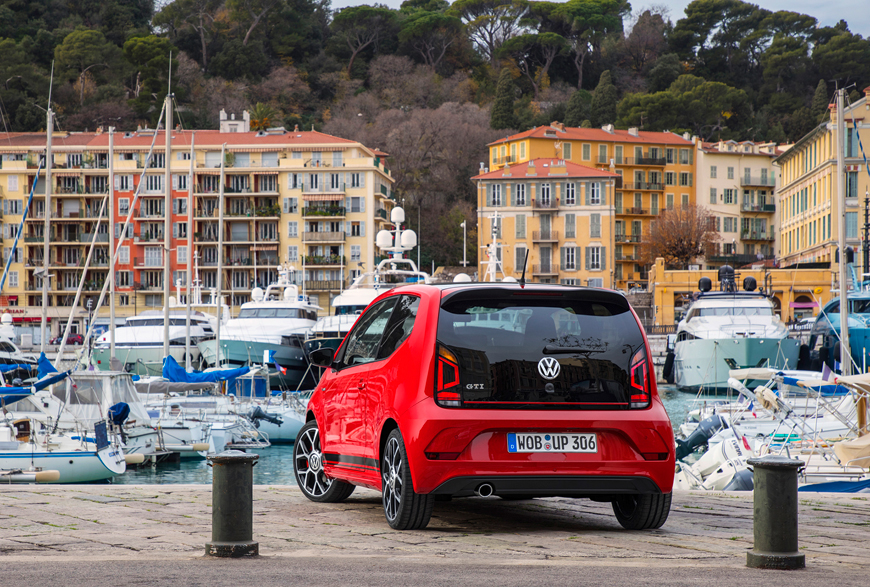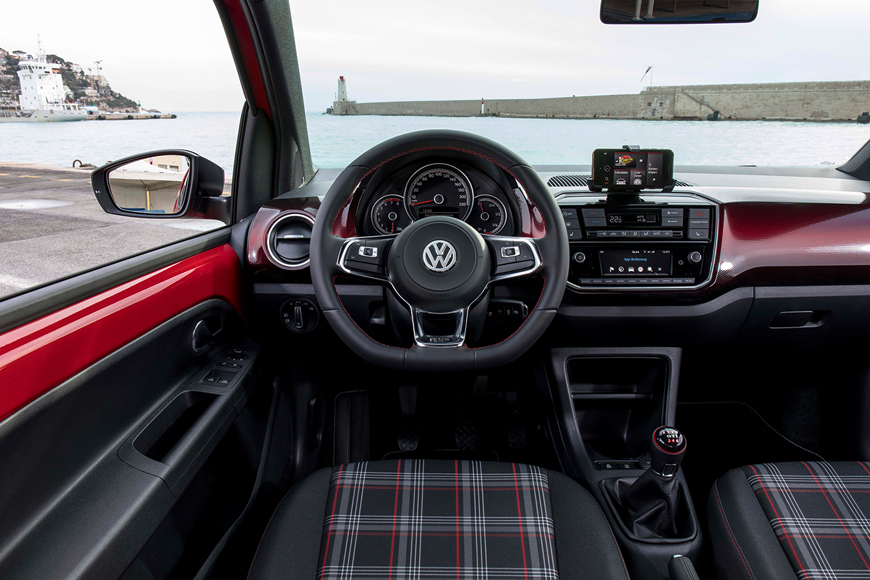With certain “grey” Volkswagen independent imports from China and elsewhere growing in sudden popularity in recent months almost exclusively consisting of less than exciting, heavy and un-sporting EV crossovers and saloons, one’s attention instead turns to the German auto giant’s less complex, lighter and sportier offerings. Smallest and least powerful, yet, closest to the brand’s historic hot hatch recipe, the Volkswagen Up GTI is conversely among Volkswagen’s most interesting and exciting sporting current European models, which in many ways would be well suited for Amman.
Uptown appeal
Launched in early 2018 but never officially imported to the region, the Up GTI presents a fresher face and more desirable driving prospect than the many bloated and bland “grey” EVs increasingly populating local roads. With its stylish design, tiny dimensions, frugal fuel consumption, nippy performance and eager dynamics, the Up GTI would be an ideally suited quick commuter for Amman’s busy and increasingly congested but often fast moving roads, as well as for ever more limited city parking situation, and incrementally rising fuel prices.
Harking back to the iconic original Giugiaro-designed 1976 Volkswagen Golf GTI in its uncomplicated but effective recipe — not to mention similar output, dimensions and weight — the Up GTI’s design is that of a modern and narrow city car, with short stubby bonnet and relatively high roofline. Angular and upright, the hot Up GTI version of Volkswagen’s urban runaround is subtly more athletic, with a tailgate spoiler, bigger alloy wheels, more prominent bumper and sills, bigger exhaust and the telltale red pinstripe detailing customary to Volkswagen’s GTI models.
Upbeat and off-beat

If not quite the high performance heavy puncher that is the current model Golf GTI Clubsport, the Up GTI and its small but prodigious turbocharged direct injection 1-litre 3-cylinder engine, nevertheless pack plenty of pep. Producing 114BHP at a comparatively low-revving 5,000-5,500rpm peak and a mighty 147lb/ft torque throughout a broad and easily accessible 2,000-3,500rpm plateau, the lightweight 1,070kg Up GTI can briskly sprint through the 0-100km/h acceleration benchmark in 8.8-seconds and onto a 196km/h top speed, yet return enviable 5.6l/100km combined cycle fuel efficiency.
A perky performer with an off-beat three-cylinder soundtrack, the Up GTI is eager from standstill with its turbocharger spooling up swiftly and with little lag. Launching with its driven front wheels digging in to tarmac and a slight torque steer tug, the Up GTI is a brisk and upbeat drive that feels even quicker, given its lightweight, small size and comparatively narrow 195/40R17 tyres. Pulling with conviction from low-end, it is confidently quick on inclines and when overtaking as it rides its muscular mid-range torque band.
Up, up and away

Somewhat low-revving for a hot hatch, one works through the Up GTI’s slick and satisfying 6-speed manual gearbox quickly and easily. With a relatively short lever throw action and intuitive clutch biting point, the Up GTI’s manual gearbox perfectly complements its frisky and fun character. Easily manoeuvrable zipping around in town and easy to place on narrow roads and to park in tiny spaces with its excellent visibility and tight 9.8-metre turning circle, the Up GTI is, meanwhile, more stable and refined at speed than expected.
Given its diminutive dimensions, it is, however, the Up GTI’s darty and nimble handling which best characterises it. With a short wheelbase and low weight and more basic torsion beam rear suspension, the Up GTI has a charming and rewardingly connected driving feel. Agile and eager into corners and ever-alert and responsive to directional changes, the Up GTI turns on the proverbial dime and delivers good steering feel. Body roll is, meanwhile, well controlled through fast sharp corners, even as the inside rear wheel goes almost lifts up.
Uplifting ambiance
Reminiscent of an old school hot hatch in its light-footed, fun-loving handling, the Up GTI, however, delivers quicker, lighter and more precise steering, and far more reassuring braking than its distant original Golf GTI predecessor. An effortlessly agile corner carving and playful hot hatch, the Up GTI also delivers reassuringly good grip levels, and is meanwhile settled in its ride, if slightly firm over sharper edged lumps and potholes. Comfortable for its class, the lightweight Up GTI well absorbs and dispatches most imperfections without feeling harsh.
Fresh and vibrant with red accents and stitching, trim graphics and tartan upholstery rather than over-ambitiously luxurious, the Up GTI’s narrow cabin is well-organised, user-friendly and intuitive, with its thick flat-bottom steering wheel, short gear lever and controls falling easily to hand. Providing good front headroom and an alert and comfortable driving position, its two-passenger rear seats are adequately if not generously sized, and accessed by folding down the front seats. Luggage volume meanwhile expands from 251-litres to a spacious 959-litres with rear seats folded down.
TECHNICAL SPECIFICATIONS
Engine: 1-litre, transverse, turbocharged 3-cylinders
Bore x stroke: 74.5 x 76.4mm
Compression ratio: 10.5:1
Valve-train: 12-valve, DOHC, direct injection
Gearbox: 6-speed manual, front-wheel-drive
0-100km/h: 8.8-seconds
Maximum speed: 196km/h
Power, BHP (PS) [kW]: 114 (115) [85] @5,000-5,500rpm
Specific power: 114BHP/litre
Power-to-weight: 106.5BHP/tonne
Torque, lb/ft (Nm): 147.5 (200) @2,000-3,500rpm
Specific torque: 200Nm/litre
Torque-to-weight: 187Nm/tonne
Fuel consumption, combined: 5.6-litres/100km
Fuel capacity: 35-litres
Length: 3,600mm
Width: 1,641mm
Height: 1,478mm
Wheelbase: 2,412mm
Track width, F/R: 1,412/1,408mm
Headroom, F/R: 993/947mm
Legroom, F/R: 1,009/789mm
Hip room, F/R: 1,417/1,388mm
Luggage volume, min/max: 251-/959-litres
Unladen weight: 1,070kg
Steering: Variable electric-assisted rack and pinion
Turning circle: 9.8-metres
Brakes, F/R: Ventilated discs/drums
Suspension, F/R: MacPherson struts/torsion beam
Tyres: 195/40R17